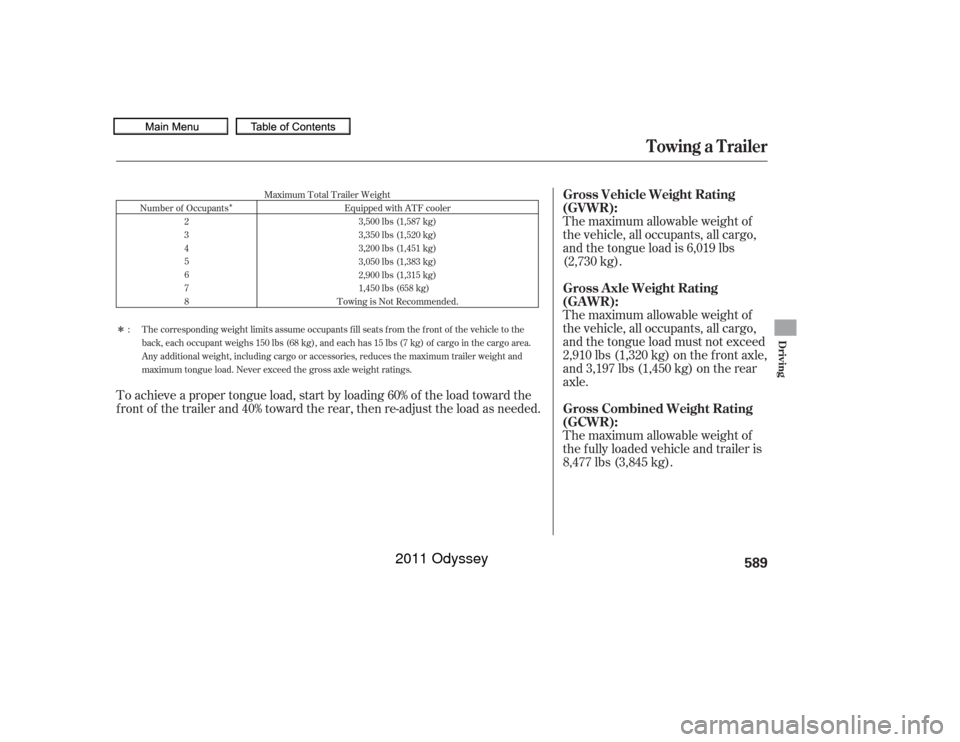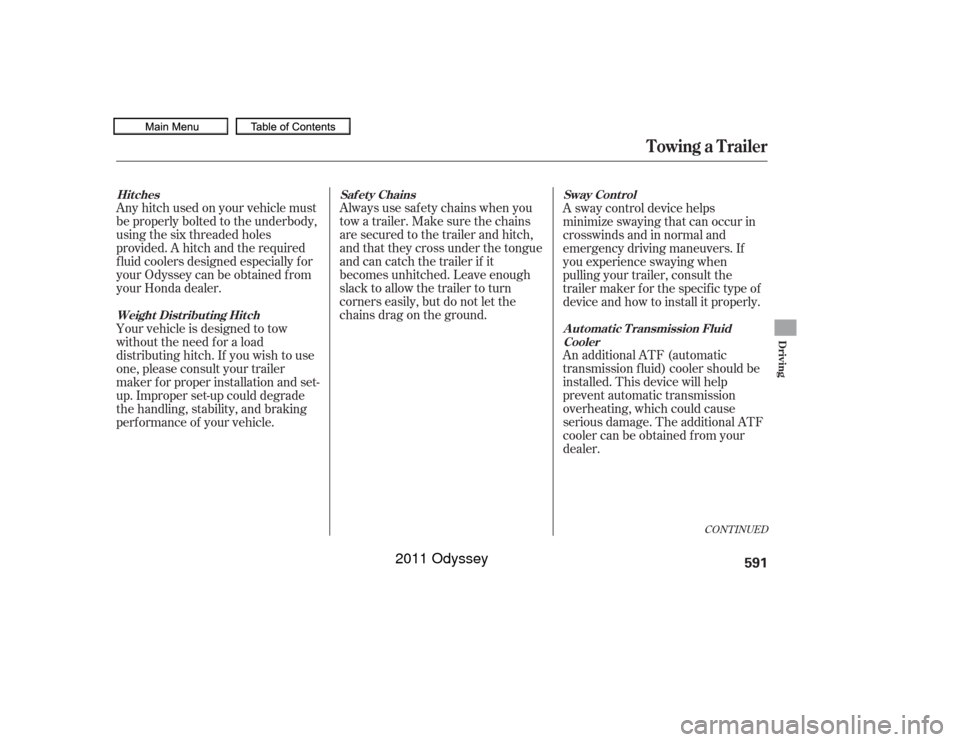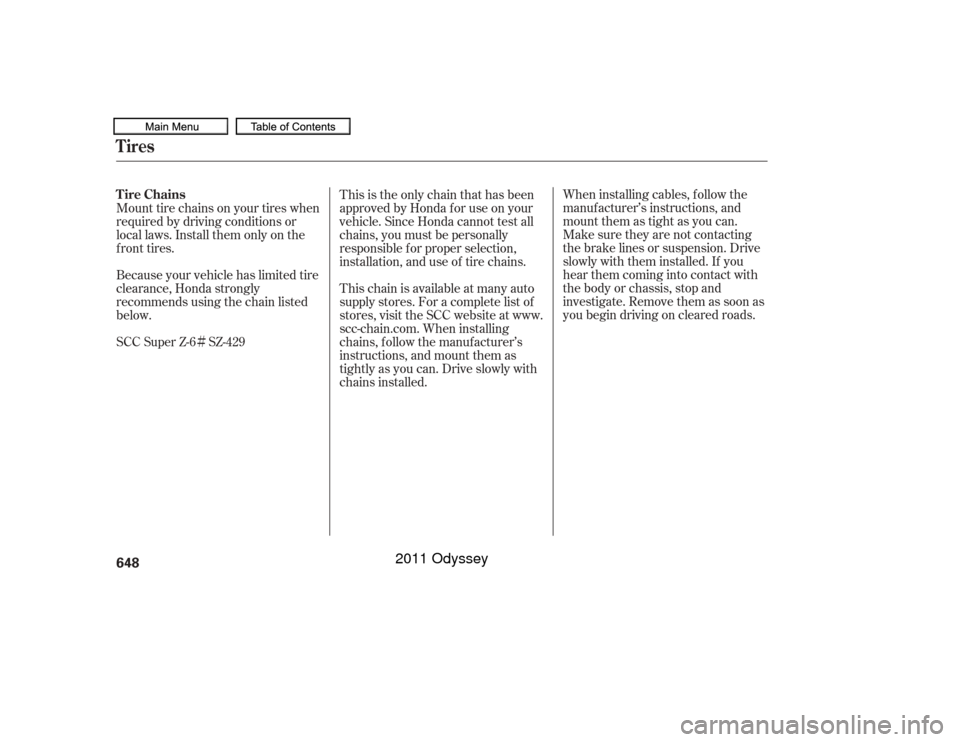Page 573 of 722

The vehicle stability assist (VSA)
system helps to stabilize the vehicle
during cornering if the vehicle turns
more or less than desired. It also
assists you in maintaining traction
while accelerating on loose or
slippery road surf aces. It does this
by regulating the engine’s output and
by selectively applying the brakes.
The VSA system cannot enhance the
vehicle’s driving stability in all
situations and does not control your
vehicle’s entire braking system. It is
still your responsibility to drive and
corner at reasonable speeds and to
leave a sufficient margin of safety.If the indicator does not come on
when the ignition switch is turned to
the ON (II) position, there may be a
problem with the VSA system. Have
your dealer inspect your vehicle as
soon as possible.
When VSA activates, you may notice
that the engine does not respond to
the accelerator in the same way it
does at other times. There may also
be some noise f rom the VSA
hydraulic system. You will also see
the VSA system indicator blink. When VSA is off, the VSA OFF
indicator comes on as a reminder.
When VSA activates, you will see the
VSA system indicator blink.
If this indicator comes on while
driving, pull to the side of the road
when it is saf e, and turn of f the
engine. Reset the system by
restarting the engine. If the VSA
system indicator stays on or comes
back on while driving, have the VSA
system inspected by your dealer.
The main f unction of the
VSA system is generally known as
Electronic Stability Control (ESC).
The system also includes a traction
control f unction. If the low tire pressure indicator or
TPMS indicator comes on, the VSA
system automatically turns on even if
the VSA system is turned of f by
pressing the VSA OFF switch (see
page ). If this happens, you
cannot turn the VSA system of f by
pressing the VSA OFF switch again.
Without VSA, your vehicle still has
normal braking and cornering ability,
but it does not have VSA traction and
stability enhancement.
571Vehicle Stability A ssist (VSA
), aka Electronic Stability Control (ESC), System
VSA OFF Indicator
Vehicle Stability Assist
(VSA ) System Indicator
570
NOTE:
10/07/17 10:51:06 31TK8600_575
2011 Odyssey
Page 581 of 722

This indicator and the warning
message on the multi-inf ormation
display will go of f , af ter several miles
(kilometers) driving, when the spare
tire is replaced with the specified
regular tire equipped with the tire
pressure monitor sensor.
Each wheel is equipped with a tire
pressure sensor mounted inside the
tire behind the valve stem. You must
use TPMS specif ic wheels. It is
recommended that you always have
your tires serviced by your dealer or
a qualif ied technician.
Never use a puncture-repairing agent
in a f lat tire. If used, you will have to
replace the tire pressure sensor.
Havetheflattirerepairedbyyour
dealer as soon as possible.If the low tire pressure/TPMS
indicator and the low tire position on
the low tire pressure monitor do not
go out af ter inf lating the tires to the
specified values, have your dealer
check the system as soon as possible.
As required by the FCC:
This device complies with Part 15 of theFCC rules. Operation is subject to thef ollowing two conditions: (1) This devicemay not cause harmf ul interf erence, and(2) this device must accept anyinterf erence received, includinginterf erence that may cause undesiredoperation.
Changes or modif ications not expresslyapproved by the party responsible f orcompliance could void the user’sauthority to operate the equipment.
This device complies with IndustryCanada Standard RSS-210.Operation is subject to the f ollowing twoconditions: (1) this device may not causeinterf erence, and (2) this device mustaccept any interf erence that may causeundesired operation of the device.
Tire Pressure Monitoring System (TPMS)578
10/07/17 10:52:06 31TK8600_583
2011 Odyssey
Page 583 of 722

A: Approximately 1.6 f t. (0.5 m)
B: Approximately 10 f t. (3 m)
C: Approximately 10 f t. (3 m)
BSI system is designed to detect
vehicles in specif ied alert zones
adjacent to your vehicle, particularly
in harder to see areas commonly
known as ‘‘blind spots.’’When BSI detects a vehicle in an
alert zone, a BSI alert indicator
comes on near the corresponding
outside rearview mirror.
While your vehicle is moving
f orward at a speed between 6 mph
(10 km/h) and 100 mph (160 km/h),
the BSI alert indicator comes on
under either of the f ollowing
conditions:
The system will not alert you to all
vehicles in blind spot zones (such as
vehicles you have just passed which
youshouldalreadybeawareof)
unless it remains in the alert zone f or
approximately 2 or more seconds.
While the system is on, BSI is active
whenever the shif t lever is in the D
or D4 position.
Another vehicle overtakes you,
entering the alert zone from
behind, at a speed that dif f ers
f rom your vehicle’s speed by no
more than 31 mph (50 km/h).
You pass a vehicle at a speed that
differs from that vehicle’s speed
by no more than 12 mph (20
km/h). The indicator comes on
approximately 2 seconds af ter the
vehicle enters the alert zone.Blind Spot Inf ormation System (BSI)BSI System Operation580A B
CALERT
ZONE
10/07/17 10:52:19 31TK8600_585
2011 Odyssey
Page 590 of 722
As required by the FCC:This device complies with Part 15 of theFCC rules. Operation is subject to thef ollowing two conditions: (1) This devicemay not cause harmf ul interf erence, and(2) this device must accept anyinterf erence received, includinginterf erence that may cause undesiredoperation.
Changes or modif ications not expresslyapproved by the party responsible f orcompliance could void the user’sauthority to operate the equipment.
This device complies with IndustryCanada Standard RSS-210.Operation is subject to the f ollowing twoconditions: (1) this device may not causeinterf erence, and (2) this device mustaccept any interf erence that may causeundesired operation of the device.
Blind Spot Inf ormation System (BSI)
Driving
587
10/07/17 10:53:05 31TK8600_592
2011 Odyssey
Page 592 of 722

�Î
�Î
The maximum allowable weight of
the vehicle, all occupants, all cargo,
and the tongue load must not exceed
2,910 lbs (1,320 kg) on the f ront axle,
and 3,197 lbs (1,450 kg) on the rear
axle. The maximum allowable weight of
the vehicle, all occupants, all cargo,
and the tongue load is 6,019 lbs
(2,730 kg).
To achieve a proper tongue load, start by loading 60% of the load toward the
f ront of the trailer and 40% toward the rear, then re-adjust the load as needed. The maximum allowable weight of
the f ully loaded vehicle and trailer is
8,477 lbs (3,845 kg).
Maximum Total Trailer Weight
Number of Occupants 2
3
4
5
6
7
8
The corresponding weight limits assume occupants f ill seats f rom the f ront of the vehicle to the
back, each occupant weighs 150 lbs (68 kg), and each has 15 lbs (7 kg) of cargo in the cargo area.
Any additional weight, including cargo or accessories, reduces the maximum trailer weight and
maximum tongue load. Never exceed the gross axle weight ratings. Equipped with ATF cooler
3,500 lbs (1,587 kg)
3,350 lbs (1,520 kg)
3,200 lbs (1,451 kg)
3,050 lbs (1,383 kg)
2,900 lbs (1,315 kg)
1,450 lbs (658 kg)
Towing is Not Recommended.
:
Towing a Trailer
Gross Axle Weight Rating
(GA WR): Gross Vehicle Weight Rating
(GVWR):
Gross Combined Weight Rating
(GCWR):
Driving
589
10/07/17 10:53:19 31TK8600_594
2011 Odyssey
Page 594 of 722

Any hitch used on your vehicle must
be properly bolted to the underbody,
using the six threaded holes
provided. A hitch and the required
f luid coolers designed especially f or
your Odyssey can be obtained f rom
your Honda dealer.Always use saf ety chains when you
tow a trailer. Make sure the chains
are secured to the trailer and hitch,
and that they cross under the tongue
and can catch the trailer if it
becomes unhitched. Leave enough
slack to allow the trailer to turn
corners easily, but do not let the
chains drag on the ground.
An additional ATF (automatic
transmission f luid) cooler should be
installed. This device will help
prevent automatic transmission
overheating, which could cause
serious damage. The additional ATF
cooler can be obtained f rom your
dealer.
Your vehicle is designed to tow
without the need f or a load
distributing hitch. If you wish to use
one, please consult your trailer
maker f or proper installation and set-
up. Improper set-up could degrade
the handling, stability, and braking
perf ormance of your vehicle. A sway control device helps
minimize swaying that can occur in
crosswinds and in normal and
emergency driving maneuvers. If
you experience swaying when
pulling your trailer, consult the
trailer maker f or the specif ic type of
device and how to install it properly.
CONT INUED
Hitches
Weight Distributing Hitch Saf et y Chains
Sway Cont rol
A ut omat ic T ransmission FluidCooler
Towing a Trailer
Driving
591
10/07/17 10:53:34 31TK8600_596
2011 Odyssey
Page 651 of 722

�ÌWhen installing cables, f ollow the
manuf acturer’s instructions, and
mount them as tight as you can.
Make sure they are not contacting
the brake lines or suspension. Drive
slowly with them installed. If you
hear them coming into contact with
the body or chassis, stop and
investigate. Remove them as soon as
you begin driving on cleared roads.
Mount tire chains on your tires when
required by driving conditions or
local laws. Install them only on the
f ront tires.
This is the only chain that has been
approved by Honda f or use on your
vehicle. Since Honda cannot test all
chains, you must be personally
responsible f or proper selection,
installation, and use of tire chains.
This chain is available at many auto
supply stores. For a complete list of
stores, visit the SCC website at www.
scc-chain.com. When installing
chains, f ollow the manuf acturer’s
instructions, and mount them as
tightlyasyoucan.Driveslowlywith
chains installed.
Because your vehicle has limited tire
clearance, Honda strongly
recommends using the chain listed
below.
SCC Super Z-6 SZ-429
TiresTire Chains648
10/07/17 11:01:12 31TK8600_653
2011 Odyssey
Page 679 of 722
If you cannot drive the vehicle
without f ixing the problem, and you
do not have a spare fuse, take a fuse
of the same rating or a lower rating
from one of the other circuits. Make
sureyoucandowithoutthatcircuit
temporarily (such as the accessory
power socket or radio).
If you replace the blown f use with a
spare f use that has a lower rating, it
might blow out again. This does not
indicate anything wrong. Replace the
f use with one of the correct rating as
soon as you can.
Look f or a blown wire inside the
fuse.If itisblown,replacethefuse
withoneof thesparefusesof the
same rating or lower.
5.
Fuses676
BLOWN
FUSE PULLER
Replacing a f use with one that has a
higher rating greatly increases the
chances of damaging the electrical
system. If you do not have a
replacement f use with the proper
rating f or the circuit, install one with
a lower rating.
10/07/17 11:04:35 31TK8600_681
2011 Odyssey